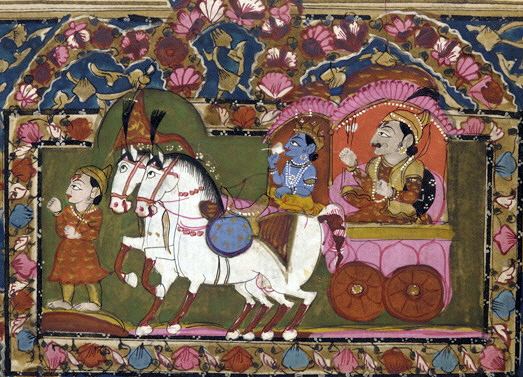 | ||
The Gītā Dhyānam (Sanskrit: गीता ध्यानम्), also called the Gītā Dhyāna or the Dhyāna Ślokas associated with the Gītā, is a 9-verse Sanskrit poem that has often been attached to the Bhagavad Gita, one of the most important scriptures of Hinduism. In English, its title can be translated literally as "meditation on the Gita," and it is also sometimes called the Invocation to the Gita.
Contents
The nine Gita Dhyanam verses offer salutations to a variety of sacred scriptures, figures, and entities, characterize the relationship of the Gita to the Upanishads, and affirm the power of divine assistance. Although differing accounts are given of its origins, the poem is widely circulated in India, and its verses have been quoted by many Hindu leaders.
Verses
The Gītā Dhyānam's first verse opens by affirming an act of meditation (anusandadhāmi): "Om. I meditate on the Bhagavad Gītā, which gave enlightenment to Arjuna... by the Lord himself" The Gītā is also affirmed as a mother (bhagavatīm, amba) who rescues from ceaseless change (bhava dveṣiṇīm). The next verse offers salutations to Vyāsa, the traditional recorder of the Gītā. Several additional verses offer salutations (namaḥ, bowing down) to Kṛṣṇa (verses 3, 5, 8), or to the supreme Godhead (devāya, verse 9).
The commonly quoted fourth verse characterizes the Gītā as a distillation of the wisdom of the Upanishads. It uses the image of the Upanishads as like cows, and Arjuna (the person to whom the Gītā is told) as like a calf who is receiving their milk. This and another selected verse are shown in the table at right, in English translation, Sanskrit original, and romanized transliteration.
The eighth verse affirms faith that God (represented in the Gītā as Kṛṣṇa) can work benevolent miracles, such as giving speech to the dumb. This verse, shown in the table, is also commonly quoted.
The remaining Gītā Dhyānam verses extoll the virtues of the Mahābhārata, the larger scripture in which the Gītā is embedded, or describe the challenges and foes overcome by Arjuna, to whom Kṛṣṇa spoke the Gītā (verses 6 and 7).
Influence
Nataraja Guru stated that the Gītā Dhyānam "is found prefixed to most Indian editions of the Gita." Swami Ranganathananda stated that in studying the Gita, "generally, before commencing the study of the text, we study what are called Gita Dhyana Slokas, 'the nine Meditation Verses on the Gita.'"
Hindu leaders have quoted or alluded to verses from the Gītā Dhyānam. Swami Vivekananda wrote from Chicago, following his attendance at the 1893 World Parliament of Religions, that "I am doing the Lord's work, and wherever He leads I follow. मूकं करोति वाचालं etc. - He who makes the dumb eloquent and the lame cross a mountain, He will help me."
Mahatma Gandhi, when praising work done at a school for orphans, wrote that "Seeing the school, I bowed my head in reverence and wondered what love could not do. It can make the dumb speak and the lame climb a mountain."
Swami Ranganathananda wrote with regard to the 8th verse that "Many saints and sages in India have used this verse again and again to express the power of Divine Grace."
Translations
Swami Chinmayananda has published a word-for-word English translation of the Gītā Dhyānam, along with extensive commentary:
Other translations into English include:
The Gītā Dhyānam has also been translated into Italian:
